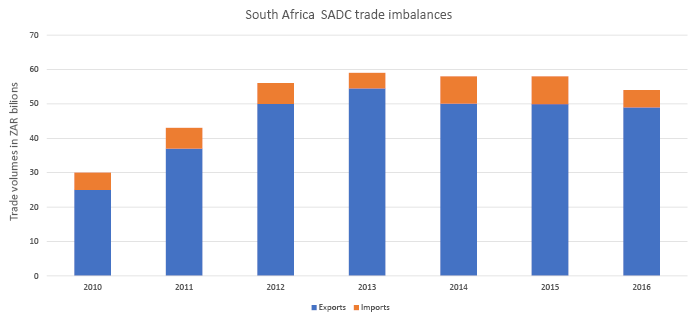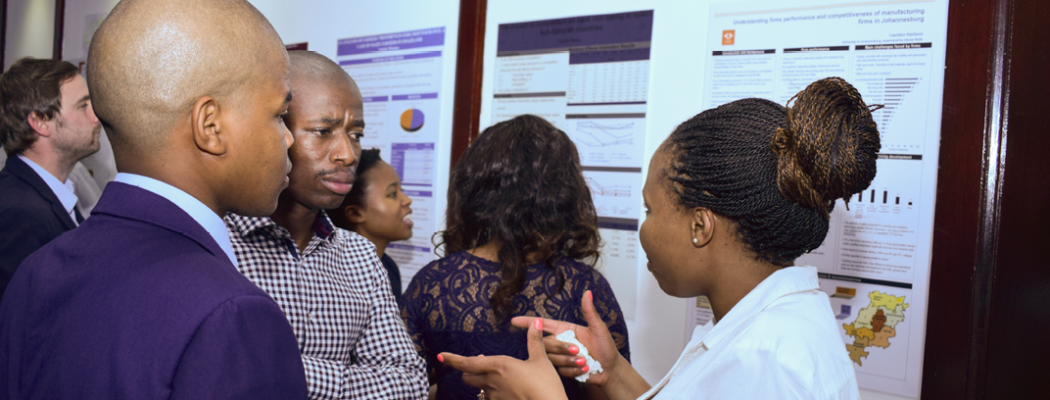Tackling poverty and inequality in Southern Africa – transnational growth corridors as a solution
Comprehensive harmonization is crucial to eliminate inefficiencies that hamper free movement of goods and services in the Southern African Development Community (SADC) region. Territorial collaboration between metropolitan clusters and rural areas connected by transport corridors is a potential key to realizing dynamic growth in the member countries.
Trade between SADC countries remains weak: the regional transport infrastructure is insufficient and the border management systems lack co-ordination
The long-term benefits of SADC countries’ full harmonization and structural transformation strategies are held back by short-term divergence of interests between member states
South Africa remains the dominant exporter of manufactured products with persistent trade surplus with regards to its SADC partners, but suffers from slow growth and high unemployment. This slows down industrialization in other member states
SADC has a weak common identity between member states
cGrowth corridors are a potential solution to advance regional complementarities and know-how on new technologies
Several challenges standing in the way of integration
The SADC is a regional economic community comprising 16 member states: Angola, Botswana, Comoros, Democratic Republic of the Congo, Eswatini, Lesotho, Madagascar, Mauritius, Mozambique, Namibia, Seychelles, South Africa, Tanzania, Zambia, and Zimbabwe. Established in 1992, SADC is committed to regional integration and poverty eradication within Southern Africa through economic development and ensuring peace and security.
Despite almost 30 years of SADC co-operation the region is still characterized by considerable spatial disparities, widespread poverty, and heavy dependence on export of raw materials.
The region’s economic integration agenda has missed most of its milestones, mainly because South Africa’s favourable trade balance coupled with persistent slow growth and high unemployment rates results in protectionism tendencies. Dependence on customs revenue for the public finances in other member states creates additional disincentives for free movement of goods and services within the region.
Figure 1: South Africa's export through Beitbridge border post on the north-south corridor

Source: Graph plotted by author with data from: Ngarachu et al. (2018)1
Currently there are several elements that stand in the way of a closer integration in the SADC region:
- SADC is still characterized by a weak intra-regional trade whereby many member states chiefly export primary commodities and count on customs revenues for public finances
- Border management is characterized by lack of harmonization in regulations, weak co-ordination, and poor interoperability of systems
- Transport infrastructures lack efficient key facilities, are in poor maintenance conditions and rail transport is underutilized, thereby missing economies of scale
- In the absence of a shared identity, South Africa remains an overly dominant player without a counterweight because of its economic and diplomatic pre-eminence. It determines the direction and pace of integration
Comprehensive harmonization would be crucial to eliminate infrastructural and regulation inefficiencies that hamper free movement of goods and services in the region. The current short-term advantages of protectionism and customs revenues are preventing the region from accessing the larger benefits of structural transformation and economies of scale offered by the larger market size of a fully integrated SADC.
Transnational growth corridors offer opportunities for reducing poverty
In these circumstances what could be the solution to overcome the structural obstacles that are holding back the SADC integration agenda? One potential solution is the creation of so-called transnational growth corridors, which facilitate territorial collaboration between metropolitan clusters and rural areas.
Growth corridors are spatial development initiatives (such as special economic zones) structured around important transportation areas to accelerate economic activity by taking advantage of geographical clustering and transportation efficiency.
At best, transnational growth corridors help economic activity to shift between sectors over time to achieve a larger market size across countries. If properly supported by improved harmonization and efficient infrastructure connectivity, they offer the opportunity for increased territorial collaboration and can contribute to reducing spatial inequalities and poverty in the SADC region.
Which way forward?
The realization of the benefits of a closer regional integration will require SADC to undertake important policy measures enabling the region to accelerate its integration by surmounting the current obstacles.
SADC can expand regional trade by putting in place an effective governance structure with a clearly assigned authority to solve intra-regional transport and border management inefficiencies. This includes increasing the role of rail transport through the rehabilitation and upgrade plan for the north-south rail track.
The growth corridors approach should be designed as part of broader spatial planning strategies that integrate different sectoral policies by combining transport and energy supply infrastructure. This should be accompanied by an industrial policy based on the comparative advantage of each territorial area or region.
The identity of member states can be strengthened by shifting the emphasis from the divergent short-term benefits of individual member states towards the larger interests of a shared prosperous future.
SADC should establish an effective governance structure with a clearly assigned authority to solve intra-regional transport and border management inefficiencies
The growth corridors approach should be designed as part of broader spatial-planning strategies, accompanied by a regional industrial policy framework
Common identity of member states can be strengthened by shifting the emphasis from the short-term benefits of individual member states towards the larger interests of a shared prosperous future
Harnessing the power of science and innovation through territorial collaboration would help spawn a new economic dynamism in less prosperous localities of the region
Establishing a common compensation mechanism for regions which may suffer short-term losses due to shifts in the regional production structure is essential
The role of science and innovation cannot be forgotten either. Regional science and innovation collaboration can be fruitful in creating new production technologies. It can also spawn new economic activities in less prosperous localities of the region by intensifying territorial collaboration between partner localities.
Shifts in production structure caused by structural transformation may cause some areas in the SADC region to suffer losses in the short term. Establishing a common compensation mechanism for such regions is essential and cannot be forgotten as a key element to achieve the shared effort for the integration of the SADC region.





